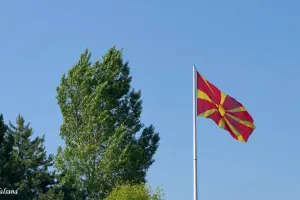This is a collection of pictures from North Macedonia. They are from different places in the western parts of the country.
If you look up all articles from North Macedonia, you will also find a world heritage site and a regular travelogue. Before you do, start with these pictures from North Macedonia.
This gallery contains images from a road trip south to north, and includes the towns of Ohrid and Skopje.
55 Photos
Afterwards, find more photo galleries on Sandalsand.
Fast facts – past
North Macedonia is a landlocked country in the heart of the Balkans, covering about 25,700 square kilometres. It shares borders with Albania, Kosovo, Serbia, Bulgaria, and Greece. The country has a population of roughly 1.8 million people and features a mix of mountains, valleys, and lakes.
Historically, the region has seen many civilisations. It was once part of the ancient kingdom of Paeonia and later came under the control of the Macedonian Empire led by Alexander the Great. Afterwards, it became part of the Roman and then the Byzantine Empire. Slavic peoples settled in the area in the 6th and 7th centuries.
For centuries, North Macedonia was under Ottoman rule, which shaped its architecture, culture, and religious life. In the early 20th century, the region was contested by neighbouring countries during the Balkan Wars and later became part of Yugoslavia. After World War II, it became a republic within socialist Yugoslavia.
North Macedonia declared independence peacefully in 1991 following the breakup of Yugoslavia. However, the country faced internal ethnic tensions, especially between the Macedonian majority and the Albanian minority. In 2001, a conflict broke out but was resolved through the Ohrid Framework Agreement, which granted more rights to ethnic minorities.
For many years, a dispute with Greece over the country’s name stalled international recognition. In 2019, the country officially changed its name from the Republic of Macedonia to the Republic of North Macedonia as part of the Prespa Agreement, clearing the path toward NATO and EU integration.
Today
North Macedonia is now a parliamentary republic and became a NATO member in 2020. It continues to pursue full European Union membership. The economy is developing steadily, with tourism, agriculture, and services playing key roles.
The country is known for its cultural diversity and historical landmarks. Lake Ohrid, a UNESCO World Heritage Site, is one of Europe’s oldest and deepest lakes. Visitors also explore Byzantine churches, Ottoman-era bazaars, and mountain villages where traditions remain strong.
Religious and ethnic diversity is a defining feature of North Macedonia. Orthodox Christians, Muslims, and other groups live side by side in a spirit of coexistence. Travellers often appreciate the country’s hospitality, affordability, and blend of old and new.
Learn about the country on Wikipedia. The text above is derived from various sources.
Map and regions
North Macedonia can be divided into three regions (source):

Povardarie: This central region consists of most of the area along the Vardar River, which somewhat bisects the country and defines much of this area. Skopje, North Macedonia’s capital and largest city, lies in the north of this region. Veles is downstream, with the ancient city of Stobi nearby. The southern part of this region contains most of the Macedonia’s wine country, in and around Kavadarci.
Western North Macedonia: Full of the bulk of North Macedonia’s tourist attractions, in particular the three national parks and the World Heritage Site of Ohrid. Two of the country’s three major lakes, Ohrid and Prespa, lie at the southern area of the western region. Many of the country’s larger cities, such as Bitola and Tetovo, are situated in the country’s west. There are also many small towns and rural areas of interest, such as at Kruševo and Mariovo.
Eastern North Macedonia: Less frequented by tourists but home to major sites in the north, including the Kokino prehistoric observatory and Osogovo Monastery. The cities of Štip and Strumica anchor much of the eastern region. In the south, Gevgelija is known for its casinos, while Dojran is home to the country’s third major lake.
Sandalsand’s pictures from North Macedonia are from a road trip from Lake Ohrid in the southwest to Skopje in the north, and onward to Kosovo.



